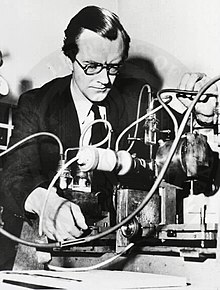Maurice Wilkins
Maurice Hugh Frederick Wilkins CBE (born December 15, 1916 in Pongaroa / Tararua District in North Wairarapa , New Zealand ; † October 5, 2004 in London ) was a New Zealand physicist and Nobel Prize winner. His research was mainly in the area of X-ray crystallography .
Life
At the age of six the son of an Irish doctor was brought to England and graduated from high school in Birmingham . He studied physics at St John's College of Cambridge University with a bachelor's degree in 1938 and received in 1940 a Ph.D. in physics at the University of Birmingham , where he research assistant to John Turton Randall was and the luminescence and phosphorescence investigated by solids. During World War II he applied this research to radar screens. He worked under Mark Oliphant (under whom he had already studied at Cambridge) on the British atomic bomb project in Birmingham (separation of uranium isotopes with mass spectrographs) and continued this in the Manhattan Project at the University of California, Berkeley , before returning to the research group of in 1945 Randall, who studied biophysics at St. Andrews University. This also became Wilkins' new area of research. In 1946, the group moved to King's College London , where the Medical Research Council established a biophysics research group.
There he dealt first with the effects of ultrasound on genetic material and then with the development of microscopes for ultraviolet microspectrophotometry, with which he also examined genetic material (nucleic acids) in cells. By studying the polarization of UV radiation, he undertook studies of the orientation of the purines and pyrimidines in the nucleic acid of the tobacco mosaic virus (TMV). He also examined the orientation of virus particles in crystals of the TMV using polarizing microscopes in the visual range of the spectrum. Then he turned to the structural investigation with X-ray diffraction and examined the DNA with it . He passed on unpublished research data from his colleague Rosalind Franklin to James Watson and Francis Crick , which enabled the latter to derive the structure of DNA in 1953. Wilkins proved that the double helix structure proposed by the two was indeed correct.
The research history of Watson, Wilkins, and Crick has been criticized for violating the rules of good scientific practice , as its publication in Nature in 1953 was based on the theft of unpublished research by Rosalind Franklin . Wilkins, an unpopular Franklin colleague at King's College , had passed Franklin's unpublished research on to her competitors Watson and Crick. Watson reports that Wilkins and his assistant Wilson secretly made copies of Franklin's work.
Wilkins taught at King's College until his death. In 1950 he became Assistant Director of the Biophysics Group of the Medical Research Council and in 1955 Deputy Director. After founding his own sub-department for biophysics at King's College (an independent department from 1961), he became an honorary lecturer there .
In 1959 he married Patricia Ann Chidgey, with whom he had a son and a daughter. He collected sculptures as a hobby and was a hobby gardener.
Awards and memberships
In 1960 he received the Albert Lasker Award for Basic Medical Research and in 1962, together with Watson and Crick, the Nobel Prize for Physiology or Medicine . In 1970 Wilkins was elected to the American Academy of Arts and Sciences . In 1959 he became a Fellow of the Royal Society . In 1962 he became CBE.
Fonts
- R. Langridge, HR Wilson, CW Hooper, MHF Wilkins, LD Hamilton: The molecular configuration of deoxyribonucleic acid. I. X-ray diffraction study of a crystalline form of the lithium salt , J. Mol. Biol., Vol. 2, 1960, p. 19
- M. Spencer, W. Fuller, MHF Wilkins, GL Brown: Determination of the helical configuration of ribonucleic acid molecules by X-ray diffraction study of crystalline amino-acid-transfer ribonucleic acid , Nature, Volume 194, 1962, p. 1014.
literature
- Maurice Wilkins: The Third Man of the Double Helix: The Autobiography of Maurice Wilkins . Oxford University Press 2003
- Robert Olby: Wilkins, Maurice Hugh Frederick (1916–2004) , Oxford Dictionary of National Biography (Online Edition)
- Renate Wagner: Wilkins, Maurice Hugh Frederic. In: Werner E. Gerabek , Bernhard D. Haage, Gundolf Keil , Wolfgang Wegner (eds.): Enzyklopädie Medizingeschichte. Walter de Gruyter, Berlin and New York 2005, ISBN 3-11-015714-4 , p. 1498.
Web links
- Information from the Nobel Foundation on the 1962 award ceremony for Maurice Wilkins (English)
Individual evidence
- ↑ eprint : Plagiarism and unethical authorship Gerhard Fröhlich, Linz (Austria) ( Memento from May 2, 2006 in the Internet Archive ) 2006
- ↑ Denis Grady: A Revolution at 50; 50 Years Later, Rosalind Franklin's X-Ray Fuels Debate New York Times , February 25, 2003
- ↑ James D. Watson: The Double Helix. Rowohlt, Hamburg 1969. (p. 208)
| personal data | |
|---|---|
| SURNAME | Wilkins, Maurice |
| ALTERNATIVE NAMES | Wilkins, Maurice Hugh Frederick (full name) |
| BRIEF DESCRIPTION | New Zealand physicist and co-discoverer of the molecular structure of DNA, Nobel Prize in Medicine |
| DATE OF BIRTH | December 15, 1916 |
| PLACE OF BIRTH | Pongaroa , North Wairarapa , New Zealand |
| DATE OF DEATH | October 5, 2004 |
| Place of death | London , England, UK |
